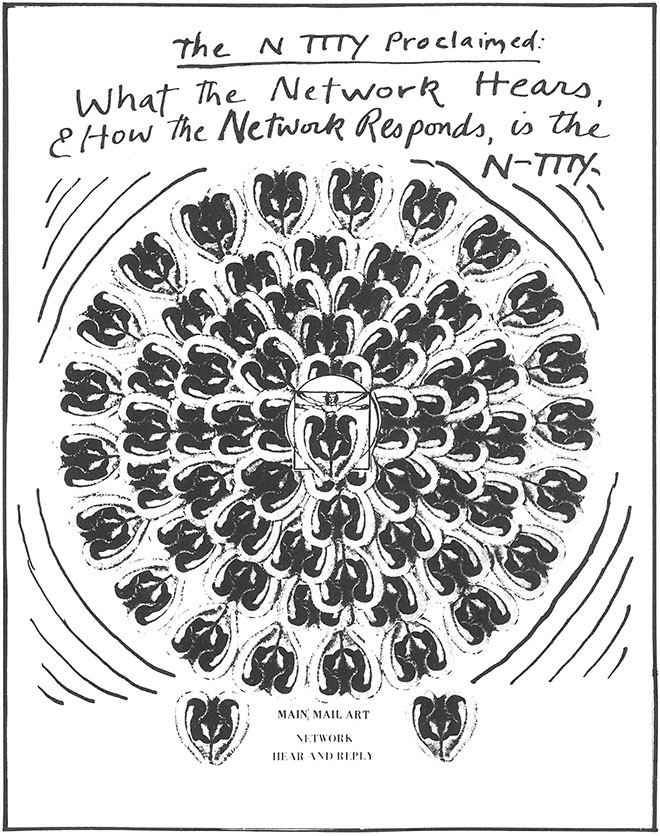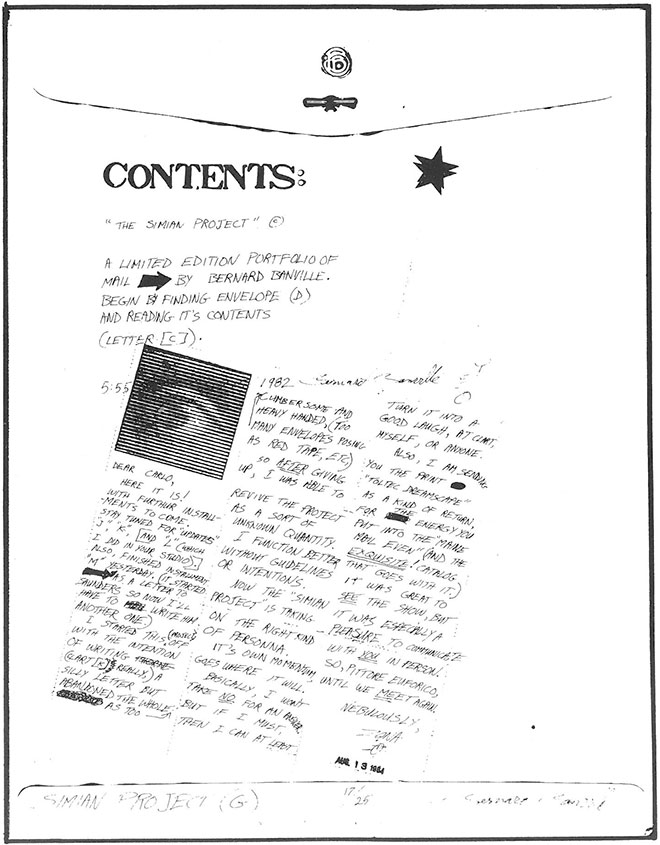Carlo Pittore: The N-tity
Pittore, Carlo: The N-Tity, in: Mail Art Then and Now, The Flue, Vol. 4, No. 3-4., Franklin Furnace Inc., New York, USA, 1984 Winter, pp. 32-34.
A PROCLAMATION: The N-tity has become the historical now & is upon us. None of us can control it, all of us Navigate it. Concurrent, coalescing energy, the N-tity is all that we share N common.
The N-tity is the vanguard expression of the explosion in the means of communication & the consequential response to this fact, & the continuing shrinkage, of time & space.
Artists have always revealed a predilection to mail or correspondence. With the evolution of government-operated post offices, which became universal in 1859, artist/poets often employed the mails in expressing their art.
The Italian Futurists, who Hailed Science (1912) and who Hailed Speed, and the New, and the Novel, and who lambasted the Art of Rome, the Art of the Sixteenth Century & the Art of Museums, and who praised the Workers and the Masses, were the first to embrace letters as a fitting democratic component of this receptivity to the New. Dada and Surrealism International also used the Letter, and Mail.
Even in 1960 the letter, quickly delivered by an efficient U.S. Post Office, cost only three cents to mail, one cent for a postal. The Fluxus Movement, Ray Johnson, and the N.Y. Correspondence School gave an American spur to correspondence as an art, & in time, even legitimacy, as well as revivifying The International. Perhaps only 200 artists were consciously mailing art in 1960. By 1980, with the letter at 20 cents each, with the Post Office much less efficient, twenty thousand artists sent mail as art.
International Mail Art is a new and significant development, & is a natural outgrowth & extension of both Fluxus, & the N.Y. Correspondence School. And all though all three movements (Fluxus, Correspondence, and International Mail Art) utilized the post office in an increasingly sophisticated & unprecedented manner, recent International Mail Art has nothing necessarily to do with mail.

Carlo Pittore: The N-tity proclaimed. 1983. Courtesy of Carlo Pittore.
Born by the desire to participate in the art of our time, International Mail Art fosters an attitude of independence, coupled with community; a willingness and a preparedness to multi- disciplines, multi-correspondence and to exhibit, perform, communicate and interrelate. Mail has been the most efficient means to get out of the studio & share ideas. With 20 cents, an envelope, and creative ideas, a mail artist gets out of the studio, exhibited, published. Mail Art is democratic, unpredictable, & individualistic. It is published, and incorporates the extremes from the handmade, to the standard, & to the reds & to the greens. International Mail Art is a splendid, sophisticated communications experiment, relying on broad international cooperation & collaboration, which, except in cases of Dictator State censorship, defies regulation, control, and market.
While International Mail Art remains the least expensive way to mount an exhibition, and is the last resort for the disenfranchised, the term 'Mail Art' has become vestigial.
International Mail Art, which boasts of artist postcards, stamps, books and magazines, telegrams, copymachine, microfilm, painting, poetry & collage, sculpture, film, etc., and which includes the hand delivered and the sent, now also includes the computer and the transmitted.
Modern technology, which has completely transformed the 20th Century, has touched everyone, and every aspect of our lives. The changes, even in the last five years, have contributed to International Mail Art, to an extent unimagined previously, in overcoming barriers of language, as well as barriers of time & space.
Concomitant with this international communications experiment and the artistic utilization of advanced technology, is the formation and sustenance of an evolving Network of idealist communicators. This Network is the foundation of the N-tity. The Microchip has made possible the technology to shortly do away with government postal systems altogether. Communications, and the concept of communications are being wholly revamped for the following historic centuries, as more individuals and groups own and operate ever more sophisticated computer terminals for an almost instant access to seemingly unlimited information and communication.

Bernard Banville: Envelope. 1983.
The evolution of the emergent microchip presents humanity with a new dynamic. If the work of Cezanne and Seurat in the last century were directed to the analysis of light, artists at the end of the 20th century must direct their attentions to the microchip. While intimately connected with the shrinkage of time and space, and continually necessitating accommodations of our internal lives to a constantly changing world, the negative components of the microchip pose a real and most alarming danger.
The handmade is obsolete.
The microchip threatens to destroy our consciousness, and threatens to destroy our sensibility, by dissolving and destroying the existence, the need for, and possibly the significance for, communication. Instant access computer terminal knowledge, that already performs major responsibilities in government, industry, and business, is already creating. The independent, individualistic, non- computer connected, must become increasingly irrelevant.
All of us are being sucked into a whirlpool of continued technological advance which is invariably robbing us of individuality, will, and humanity. We are gradually and irrevocably losing the ability to think, to feel, to see, to hear, to touch, and to have ideN-tity.
Already we imitate the computer.
We regularly sacrifice quality and substance for participation, and speed, and package everything in a standardized manner, for storage and retrieval, and this certainly must rob us of breath. We have learned to hide behind the machine, as we have hidden behind fashion. Our wills, imaginations, and abilities are being continually assaulted and sapped, as we lose the ability to create, and to appreciate the eccentric, a process already more than 100 years in motion. We have sacrificed the intimate and the detail, for the massive and the quick.
The insurpassable Mural Art of the 16th century Must Be Hailed Again. As we are realizing that technology is not necessarily our friend, or savior, its influence already has diminished the idea of the human.
Everyone and everything must fit into standardization imposed by progress. Science, which we hailed at the beginning of this century, has no soul! It is amoral. In our frenetic world, we have lost the ability to savor the sensuous and the sensate in the rush of ever higher speed expectation and profit. As technology continues to get stronger and overwhelms and subjugates us more, fragile art remains as one of the last humanizing forces.
Art is not for art's sake. Art is a standard of communication, with enormous implications. If creative time equals the time given to create an ideN- tity, Art is both individualistic and communal, and is a denial of selfishness and dehumanizing profit, and our greatest fear, that of nothingness.
The N-tity is our communal comprehensive for mounting a challenge to the onslaught of progressively inhuman technology. The pursuit of the creation of the handmade, and the survival of humanist community, regardless of its non-utility to the microchip and to profit, represents the greatest challenge to our ability to be, and to choose.
From Cell Me at League Headquarters, Grand MEhattan Island, United States of aMErica, this is a call to all who hear, to respond. What the Network Hears, and how the Network Responds, is the N-tity.
Post ME P.O. Box 1132, Peter Stuyvessant Station, N.Y.C., 10009
